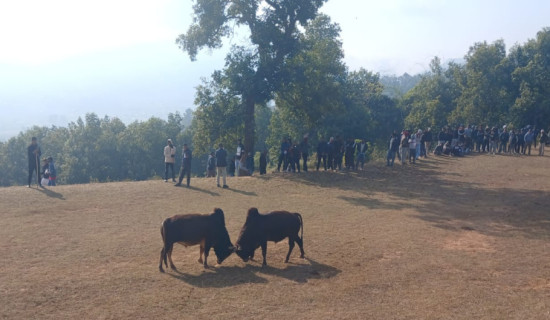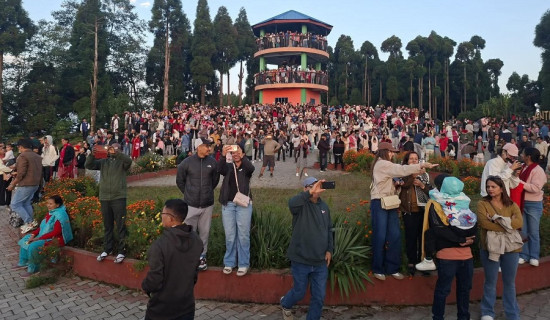- Friday, 2 January 2026
Bring Bagmati River Back To Life
A tweet by Bhishma Koirala stating, "During the 30 years from B.S. 2051 to B.S. 2081, there has been a change of 16 bosses, approximate expenditure of 10 billion Nepali rupees, and who knows how many became millionaires but Bagmati is still the same without revival," is indeed a point to ponder. He is referring to the High-Powered Committee for Integrated Development of the Bagmati Civilization (HPCIDBC).
Last year, during the rainy season, the Bagmati River that flows in the Kathmandu Valley was gushing with water for a short period. But as the rains subsided and dry seasons commenced, the river hardly had water, but there was stench along the banks and the neighbourhood surrounding Bagmati, including the Pashupatinath area among other spots in the valley.
Futile attempts
So why hasn’t Bagmati been cleaned and revived even after several attempts from the government and civil societies? There have been periodic cleaning efforts and tree plantations along the banks, but somehow no progress has been made. Money has been poured in, but the question is, has it been used properly to truly revive the river to the glory it used to be? I remember as a child during the 1970s while going to school, crossing the Bagmati River at Thapathali used to be sheer pleasure. We used to pray till we crossed the bridge, asking the Bagmati and all gods to make us come first in class. The freshness of the river and the water always swirling below probably made us believe our wishes would come true.
Now, while crossing the brand-new bridge over the same old river, we need to pray that the stench coming from there, instead of the fresh air that used to rejuvenate our lungs, would go away and somehow the river could be revived back to its original glory. There are ample examples of how rivers have been revived all over the world. Some examples in neighbouring India could help us see where they have gone right and where we could have gone wrong. Nepal has made excellent progress in reforesting the country and increasing our forest area, but why have we lagged behind in reviving the holy river like Bagmati?
Trees play a major role in reviving rivers. They make the soil porous so that rainwater seeps in through and reaches the dry aquifers of the river. The roots conserve the soil and guide water to flow in and help in the rejuvenation process. There have been several efforts in India, like planting 6.1 million trees to revive 47 rivers by the Art of Living setup. While Nepal has a successful track record of increasing our forest area by reforestation and there have been efforts of planting trees along the banks of Bagmati, the caring and nurturing of the trees seem to be neglected. The residents of the valley now need to seriously take it upon themselves to restore Bagmati back to what it used to be.
One inspiring work is of Abhay Todkar, who is a resident of Man Taluka of Maharashtra, India, and has been on crutches due to the disability of normal functioning of his right limb. Since 2012, he personally started working from 6 to 10 am to mobilise the villagers in that area to take action to solve the problems of scarcity of water there. Although a lone campaigner initially, he was finally joined by 650 villagers from Man Taluka, Satara, Maharashtra, to build a gabion dam, deep contour trenches in 45 days to make water storable and harness rainwater naturally. This village that had been hit by drought now has water storage capacity of 25 crore litres.
Climate change impact
Another example is the Naganadhi River in Kammavanpettai village in Tamil Nadu, India. Women still have the burden of the care economy and need to attend to the daily survival of the families and water is one of the main element of life. The women of this village seem to have been in despair at one point as their source of water, the Naganadhi, was almost dry for two decades. According to the Art of Living, the men in this village were addicted to alcohol and unemployed. With the motivational guidance of the Art of Living River Rejuvenation project, 20,000 women were mobilised in that area to revive the Naganadhi River back to life. These are small but significant community efforts which have provided life-saving water in places where there was no water and where rivers were drying off.
Climate change has an impact on our daily lives and although it is talked about by all, the internalisation of protecting our natural resources still has not happened. The adverse impact of climate change and environmental degradation is drying off rivers. Human civilisation has always thrived around meandering rivers, but human beings have left no stones unturned to pollute rivers and push them into extinction or make them drains that make it difficult for people to breathe around the area they exist. The time has come to question where the billions of rupees allocated to Bagmati has actually gone and take action against any misappropriation that has happened. Equally important is for the residents of the Kathmandu valley to come together to revive Bagmati back to life.
(Sharma is a senior journalist and women rights advocate. namrata1964@yahoo.com and twitter handle @NamrataSharmaP)
















